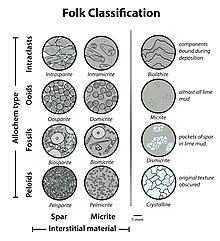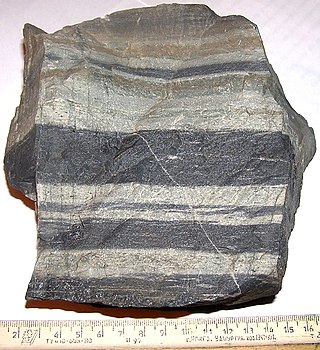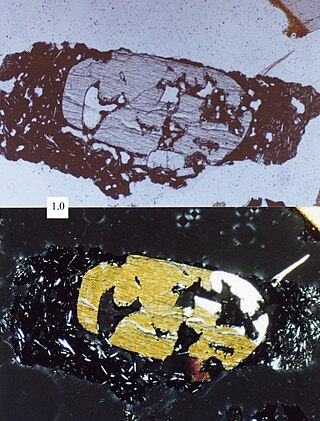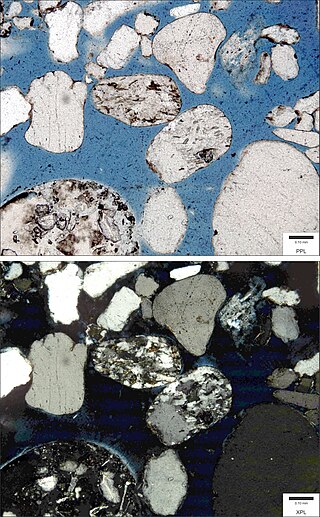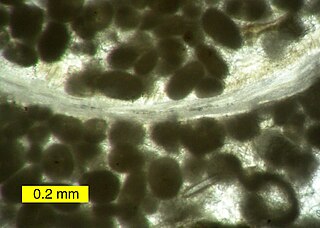Folk's sandstone (clastic) classification
Folk's philosophy is that the name of a rock must convey as much information as possible without being a complete description. For this, he proposed five important properties of sandstones to use as defining characteristics. These five properties are: grain size, chemically precipitated cements, textural maturity, miscellaneous transported constituents, and clan designation. Folk's fivefold name must be in the following format:
- (Grain size): (chemically precipitated cements) (textural maturity) (miscellaneous transported constituents) (clan designation)
However, Folk stated that cements and miscellaneous transported constituents are optional categories as they are not always observed. The other three properties should always be mentioned.
The following are examples of rock names using Folk's fivefold name:
- Coarse sandstone: calcitic submature micaceous subarkose
- Fine sandstone: supermature quartzarenite
- Sandy granule conglomerate: calcitic submature calclithite
- Very fine sandstone: chert-cemented submature quartzose phyllarenite
- Clayey very fine sandstone: immature fossiliferous plagioclase arkose
Clan designation

As others before him, Folk proposed a classification for sandstones based on the relative abundances of quartz (Q), feldspars (F), and rock fragments (R). These are the main poles of the classification diagram.
To define the clan name one must normalize the sum of abundances of quartz, feldspars and rock fragments to 100%. This means that other constituents that don't fit in these categories are disregarded. After this, the relative percentages of quartz, feldspars and rock fragments are used to plot the appropriate point on a QFR triangle and obtain the clan designation.
There are some exceptions when summing the abundances. Due to the difficulty in distinguishing quartz from metaquartzite rock fragments, metaquartzite is always plotted on the Q pole of the QFR diagram along with quartz. Granites and other phaneritic igneous rock fragments are plotted in the F pole of the diagram.
If the abundances of quartz, feldspars and rock fragments indicate that the rock is an arkose, a subarkose or a lithic arkose, one must then normalize the abundance of feldspars to 100% and attempt to identify the relative abundances of K-feldspars to plagioclase in the sample. If there is more plagioclase than there is K-feldspar, the rock is either a plagioclase arkose, a plagioclase subarkose or a lithic plagioclase arkose, respectively. If there is more K-feldspar than there is plagioclase, or if it is too difficult to make a distinction between the feldspars, the name stays as arkose, subarkose or lithic arkose, respectively.
If the abundances of quartz, feldspars and rock fragments indicate that the rock is a litharenite, a sublitharenite or a feldspathic litharenite, one must then normalize the abundance of rock fragments to 100% and attempt to identify the relative abundances volcanic rock fragments (VRFs), metamorphic rock fragments (MRFs) and sedimentary rock fragments (SRFs). If the relative abundances cannot be identified, then the clan name is simply obtained from the QFR triangle. If the relative abundances can be obtained, one must plot the appropriate point in the VRF-MRF-SRF triangle to obtain the clan name. If the point plots in the sedarenite field, one must then normalize all the sedimentary rock fragments to 100% and attempt to find the relative abundances of carbonate rock fragments (CRFs), chert fragments and sandstone fragments (Ss) and shale fragments (Sh). Using this information one must plot the point in the CRF-chert-Ss, Sh triangle and find the appropriate clan name. If the relative abundances of different sedimentary rock fragments cannot be obtained, then the rock is called a sedarenite, subsedarenite or feldspathic sedarenite, respectively.
The name must be as specific as possible and one must try to avoid using broad terms like litharenite or sedarenite if the necessary information is available.
Miscellaneous transported constituents
Miscellaneous transported constituents are any grains that do not fall into the categories described by the QFR diagram. These usually include heavy minerals or fossil fragments. These constituents provide a signature for the observed formation and will help correlating between various samples.
Textural maturity
Textural maturity is a property that relates to the amount of mechanical energy input on transported sediments through the abrasive power of currents and tides. It is observed in certain characteristics such as rounding and sorting of the grains. Folk states that as more mechanical energy is applied to transported sediment, this sediment will pass through the following four stages sequentially:
- Immature stage: The sediment contains more than 5% clay and sand grains are poorly sorted and angular.
- Submature stage: The sediment contains less than 5% clay and sand grains are poorly sorted and subangular to subrounded.
- Mature stage: The sediment contains little to no clay and sand grains are well sorted but not well rounded.
- Supermature stage: Sediment contains no clay and sand grains are well sorted and well rounded.
Cements
Cements are authigenic minerals precipitated in the pores of clastic rocks. The composition and texture of these cements depends on the chemistry of the water in the pore, the surrounding mineralogy, and the temperature and pressure conditions during cementation.
Grain size name
Grain size refers to the diameter of the largest possible inscribed circle in a grain. In Folk's classification scheme, one uses the Wentworth scale to find the appropriate grain size name.
